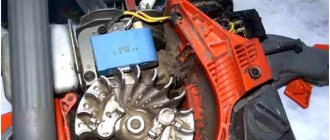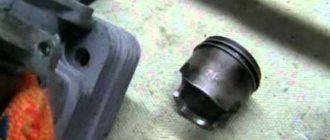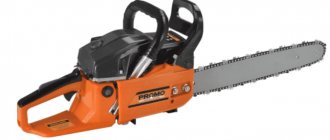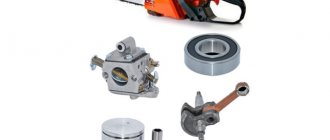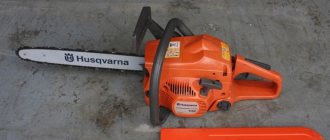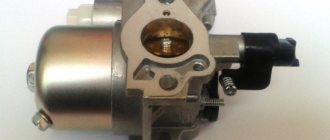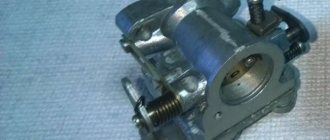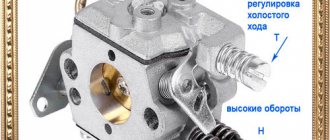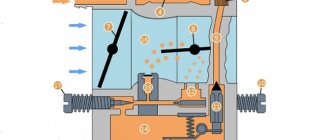What to do if the spark plug is flooded on the chainsaw
If you suspect a flooded spark plug, you need to inspect it.
Using a spark plug wrench, it is unscrewed and carefully examined. If the spark plug is wet, but there is a spark, then it has definitely been flooded. Many experienced owners are able to determine with a high degree of probability the current condition of a candle by its color. It is recommended to carry out this procedure regularly.
- Light brown soot is exactly what all owners want to see. In this case, the functionality of the chainsaw is not impaired.
- Black carbon deposits indicate an unbalanced mixture, namely a lack of oxygen in the fuel chamber. If the situation does not improve, there is a high probability that the chainsaw spark plug will flood again.
- If corrosion is detected on the fork or the distance between the electrodes is too large, then most likely a lean fuel mixture is used.
Setting the ignition coil gap.
Most modern models of chainsaws and trimmers do not require setting the ignition timing. It is set by specially defined places for grooves on the flywheel and crankshaft shank for the keyed connection of these two parts. The following malfunctions often occur at the junction of these parts:
- the seats for the key on the flywheel and crankshaft are broken
- the key wears out and the crankshaft turns on the key
As a result, both parts (depending on condition) will need to be replaced in the event of a malfunction. Such problems are often caused by a loose nut holding the flywheel to the crankshaft.
It is only necessary to correctly set the gap between the flywheel and the ignition coil. Depending on the tool model, the gap size may vary. Usually it is 0.2-0.4mm. Important : the gap is set from the side of the magnets and the ignition module. Since the flywheel is round, a regular car feeler gauge will not work for this purpose. It would be technically correct to set the gap according to a special template. But it is not always possible to purchase it. It is unwise to buy such an expensive template for one-time use. Instead of a corporate template, you can use a strip from a plastic water bottle. Cut a strip from the bottle in the place where there is no relief embossing. You can also use a plastic card (not too thick). Further steps for setting the gap are approximately the same for both chainsaws and trimmers:
- Loosen the ignition mounting bolts.
- Connect the magnets on the flywheel to the ignition coil
- Holding the plate between the flywheel and the coil, tighten the mounting bolts.
- Remove the strip
- Rotate the flywheel 360 degrees several times, making sure that it does not catch on the reel anywhere.
All. The gap between the coil and the flywheel is set. Before reassembling, rotate the flywheel and make sure that it does not catch anywhere.
Note: Do not use paper as a template. It does not have the proper elasticity; when tightened, it will definitely deform and the gap will be incorrect.
Repairing the ignition coil is impossible and impractical. Below is a list of ignition coils that can be purchased on our website.
The owner of a summer cottage cannot do without a lawn mower or a trimmer. However, during its operation, there are variations in situations where this unit for some reason stops starting. And you will like the circumstances of this a lot more. Let's find out why a gasoline trimmer won't start.
To find out why a gasoline trimmer starts up poorly or constantly stalls, you need to check the operation of all the main components of the unit one by one. It is especially important to do this after storing the lawn mower for a long time. What is needed, the main prerequisites for such behavior of the trimmer are as follows:
- The culprit that the lawn mower does not start may be a bad oil-gasoline fuel mixture. It must be prepared strictly according to the instructions. Saving here is completely inappropriate, as it leads to wear and tear of the entire piston group of the trimmer. You should not prepare a lot of fuel mixture, because excess gasoline will lose its properties over time.
- You need to know that gasoline trimmers of brands such as Stihl, Husgvarna and some others will not start if cheap gasoline with a low octane number is filled in. For such units, only high-quality high-octane fuel should be used.
- If the trimmer stalls immediately upon startup, then, you know, its spark plug is flooded. In this case, you need to turn it out and dry it well for half an hour. Then drain the excess fuel that is in the chamber, clean the spark plug from carbon deposits, place it at its destination and try to start the lawn mower.
- If your new gas trimmer won't start, you may be more concerned with the lack of spark. And this happens because the socket where the candle is located is dry and combustible does not ignite. You should slightly moisten the threaded connection of the spark plug with a few drops of gasoline.
- A gasoline trimmer may stall due to clogged air or fuel filters. It is much better to replace such elements with new ones.
- The exhaust channel and breather can also become clogged. By cleaning these trimmer elements, you can start the unit without any special problems.
- Another reason why the gasoline trimmer does not start, even when there is a spark , and the carburetor may be clogged. To clean the channels and jets, you need to blow them with compressed air using a compressor.
Weak spark!? The engine won't start. Question for ELECTRICIANS. (Discussion)
Use a special wash to clean the carburetor.
- If the carburetor gaskets are worn out, they need to be replaced. And if the density of this device is violated, you will have to find the faulty carburetor part and replace it.
- The trimmer may not start due to wear on the piston group. But it is better to change such parts of the lawn mower at a car service center.
Trimmer line - which one to choose?
Immediately after purchasing a weed trimmer, we are faced with a lot of questions - how to use it correctly, how to refuel it (if we are talking about a gasoline tool), it is clear which fishing line is much better to choose. You can find the answer to the last question in the text of the article.
How to quickly remove a stump without uprooting it?
Related Posts
Probably at some point gardeners are faced with the need to cut down trees growing in this area. Then the stumps remain; if the trees were of significant size, uprooting them is very problematic. The text of the article tells about other methods of getting rid of stumps.
Treatment of currants in the fall from pests and diseases
Every summer resident grows currants, which are loved because of their own taste properties and required parameters. She asks for appropriate care, which includes treating plants from pests and diseases. The features of these autumn events are described in the text of the article.
How to choose a gasoline weed trimmer?
A beautiful well-groomed lawn is a decoration for any area. And constant haircut helps maintain its attractiveness. You can't do this without a lawn mower or trimmer. Based on the text of the article, we will talk about the intricacies of choosing a gasoline trimmer.
In most cases, this happens to beginners when, at the first start, they miss a “pop” on the closed air damper and continue to pull the starter handle, respectively, a lot of gasoline comes out in the combustion chamber, and not enough air prevents the gasoline from igniting.
- Use a spark plug wrench to unscrew the spark plug and check its condition. If the spark plug is wet and a spark , then it has been flooded. We open the air damper, turn on the switch button, squeeze the gas “all the way” and start it. Excess gasoline should come out of the exhaust saw and the saw will start.
- Use a spark plug wrench to unscrew the spark plug and check its condition. If the spark plug is wet and a spark , then it has been flooded. Turn the chainsaw over with the spark plug hole facing down and turn the starter 10 times; here excess fuel will flow out of the engine cylinder. Then wipe dry (calcinate) the spark plug, or replace it with a new one and try again to start the engine exactly following the instruction manual. If the spark plug is completely dry, this means that no fuel is entering the engine. And since there is of course some in the tank, there may be a problem in the carburetor. You can put a little consistency into a syringe, inject it into the cylinder, tighten the spark plug and try to start the engine. If the engine starts and then stalls, the problem remains and you need to contact a service center.
Read also: Bessemer steel production process
You have no rights to post comments
Some gardening tools are useful and effective, but there are times when the equipment refuses to work. Among them was a trimmer, which can be used to mow both a small clearing and large lawns.
There are various reasons why a gasoline trimmer does not start:
- The most common cause of breakdown lies in the wrong choice of fuel. Often, very economical users of the device fill the tank with something incomprehensible, but in no way flammable with a regular octane rating. Bad fuel, kept in a plastic canister for a long time, has a terrifying effect. The device, which has therefore lost its functionality, is sent for a complete overhaul of the mechanism.
Despite the simplicity of the design of the chainsaw, if there are interruptions in its operation, and sometimes even with a complete failure of the unit, it is quite difficult to find the cause of the problem. Of course, an experienced technician will be able to immediately determine what led to this or that failure. But the average user, in order to find chainsaw malfunctions and carry out repairs with his own hands, will need to study the symptoms that are inherent in a particular breakdown.
What to do
If the chainsaw engine does not start and there are traces of fuel and oil on the spark plug electrodes, it is necessary to establish the cause of their appearance. This will determine what needs to be done to eliminate it. If fuel injection occurs when starting the unit, then it is necessary to remove the fuel mixture accumulated in the engine crankcase. To do this, turn the spark plug out, turn the chainsaw upside down and turn the crankshaft with a manual starter. Such manipulations need to be done at least 25-30 times.
After this, the removed part is put back in place and the engine is started in accordance with the operating instructions. If interruptions occur during the operation of the unit, this indicates a defective spark plug. Over time, the electrodes of the spark-forming device burn, resulting in an increase in the gap between them. This results in a weak spark that cannot ignite the fuel.
Unburnt fuel settles on the electrodes and sparking stops.
The gap is adjusted using a feeler gauge. For two-stroke engines, the distance between the electrodes should be 0.7-0.9 mm. Splashing of contacts can occur due to an overly rich mixture. This can be caused by poor carburetor adjustment or a clogged air filter.
The device is set up on a warm engine. By rotating the screws, the maximum possible stable speed is achieved. If the owner of the unit has not adjusted the carburetor, then you should contact a specialist.
Chainsaw Oleo Mac 936 Doesn't Start
Content
Chainsaw Oleo
Mac 936 - Italian model of the past decade
Owners of houses and summer cottages have the opportunity to complete their set of household tools with the development of the Italian brand Oleo Mak. In a rational version, this is an Oleo Mac 936 household chainsaw.
The exact technical and operational characteristics of this model are determined by the highest quality of the materials used, the use of modern production and assembly technologies.
Photo: Mac 936 chainsaw
Implementation circle
When working on the tool project, experience in the comprehensive operation of past developments, technical know-how and achievements of global mechanical engineering are used.
In the private sector, the Oleo Mac 936 chainsaw, universal in some respects, is effectively used:
- for the preparation of wood fuel;
- structural cutting of construction wood;
- for the formation of woody and plant landscape interior;
- for a wide range of household work related to sawing different types of wood materials.
Performance characteristics
The tool differs from similar models in its flexible traction parameters and savings in consumables, easy maintenance and comfortable operating conditions.
READ Correctly Installing a Chain on a Chainsaw
Chainsaw Oleo-Mac gs350 repair
Manufacturer: Oleo Mac
Model: GS 35 C country of origin Italy Cylinder volume: 35.0 cm3 Motor power: .
Repair of Oleo-mac chainsaw (oil pump, carburetor)
Oleo Chainsaw Repair
—
mac
(oil pump, carburetor) Service website. Vkontakte community .
This is facilitated by the supply of torque of the unit, an economical and easy-to-adjust carburetor, and a low level of vibration and background noise. Operational safety is ensured by the design of an emergency shutdown mechanism, which blocks the movement of the chain in the presence of unusual situations.
The advantages of this model are the level of maintainability. Using spare parts and consumables, the owner of the saw can restore its functionality with the least expenditure of material resources.
The annotation included with the kit will help you avoid making annoying mistakes in the process of preparing the tool for work, perform routine maintenance on time, and promptly remove possible failures and malfunctions.
Technical properties
The Oleo Mak 936 saw, weighing 4 kg, is characterized by compact body dimensions, which do not exclude comfortable access to the adjustment and adjustment units and the filling necks of the fuel and oil tanks.
The model is equipped with a reliable and long-lasting two-stroke air-cooled internal combustion engine, with a working volume of 35.3.5 cm3 and a power of 2.7.5 hp. To perform carburetor drive work, a mixture of high-octane gasoline and special motor oil is used. Fuel enters the carburetor from an internal tank with a volume of 400 ml.
- The loaded parts and components of the unit are made of special forged steel.
- The piston group has been improved due to the installation of an additional compression ring.
- A quick start is guaranteed by a manual starter coupled with a primer pump and an electric ignition system.
Source
Is everything intact, clean, and working?
Let's try to adjust it. We take a long screwdriver, find the idle speed adjustment bolt (it is located on the throttle valve), tighten it a couple of turns so that the valve opens slightly. Let's start it up. Does it work smoothly? Then let's move on. Won't start or stalls? Opens the throttle slightly until it starts reliably.
Next, we adjust the quality of the mixture with screw L. We need to achieve maximum idle speed. Here the principle is the opposite - the more the bolt is unscrewed, the richer the mixture. After this, the quality of the mixture is adjusted at maximum speed with screw H.
If adjusting the carburetor does not bear fruit, then it needs to be disassembled. Inspect the membrane, clean the jets and internal passages. To do this, you need not only to have a repair kit, but also, preferably, a spare carburetor.
Criteria for the selection and operation of spark plugs
The simplest indicator of mixture quality is the porcelain insulator of the spark plug center electrode. Any shade of brown indicates normal quality of the mixture; white or sooty insulator indicates a poor or over-enriched emulsion composition.
The heat rating of the spark plug in use must meet the stated requirements.
- The cause of oiling may be a so-called “cold” spark plug, which can be visually identified by a short insulator. Interruptions in sparking are possible if the gap is adjusted incorrectly or due to natural contact burnout.
- The recommended distance between the spark plug contacts is indicated in the instructions; in the absence of information, you can focus on the standard value of 0.7-1 mm. With a smaller gap, the efficiency of ignition of the fuel-air emulsion decreases; with an increased gap, interruptions in spark formation are possible.
- It is not recommended to burn a damp or oily candle on an open flame due to the risk of cracks and premature failure.
Over-enrichment of the mixture in the combustion chamber of a technically sound chainsaw is eliminated by purging the engine. To do this, just remove the spark plug and crank the crankshaft several times with a manual starter.
Methods for checking the ignition module.
The only sure way to diagnose the serviceability of an ignition coil is to replace it with a known working test sample: if after replacement everything works as it should, then the problem was with the coil. If you don’t have one, then move on.
To eliminate possible malfunctions from the wiring and shutdown buttons, disconnect the control wires from the coil during the test.
- Measuring coil resistances. This method is not always applicable: firstly, you need to know the resistance parameters of the coil windings. Secondly, in addition to the inductor, the ignition contains semiconductor elements to form the required high-voltage pulse. As mentioned above, their malfunction can only appear when heated. To measure the module correctly, it is necessary to disconnect the armor wire and cap from it, which cannot be done without consequences. In short, reliable measurements are possible when the correct parameters are known and carried out under operating conditions.
- Using a device that checks for the presence of a spark. It is mounted in the open circuit between the spark plugs and the high-voltage wire of the ignition coil. The device is expensive and is used mainly in serious service centers. As an example, the ignition system tester from Shtil ZAT 4. Price $30-50.
- With the help of a candle. Remove the spark plug and place its body against the cylinder. Pull the starter and watch for a spark between its contacts. This method is approximate and does not give a complete picture of the state of the ignition coil, since the spark plug is not “under pressure” and the flywheel will rotate faster due to the lack of compression in the engine (the spark plug is turned out)
- "Barbaric" way . It is used at your own risk in hopeless situations.
- remove the cap from the candle and insert a nail into it. Be careful not to damage the inside of the cap - then put it back on the candle and use it. It is better to bite off the head of the nail. Otherwise, it may be difficult to remove it.
- position the nail 6-7mm from the cylinder.
- “start” the engine, that is, perform the usual actions when starting the tool. This will force the ignition system to work. Please note that the candle must be screwed into the spark plug hole.
- look at the presence and color of the spark. Ideally, the spark should be “strong” and bright blue. Everything else is a sign of a malfunction.
- Important points:
– the spark plug must not be unscrewed: the lack of compression will lead to faster rotation of the flywheel, which will not correspond to real operating conditions
– if there are electronic components in the ignition system, then this method can damage them
– the distance between the nail and the cylinder models the compression and dielectric properties of the fuel mixture. The distance of 6-7mm is approximate and may differ on different product models.
Read also: Which sander is best for sanding a wooden floor?
The philosophy of the method: there must be a large gap between the nail and the cylinder, the spark must be “strong” and bright blue
To avoid using a nail, you can make your own probe. To do this, you need a new spark plug that is known to work. Increase the gap in it to 4-5 mm. Next, we put a cap on it, apply it to the engine and evaluate the quality of the spark. It should be “strong” - clear and bright. Under conditions of high pressure and temperature, it will be able to ignite the fuel mixture. A weak spark will not do this. Ignition occurs later or does not occur at all. Uneven operation of the engine occurs, the engine does not gain speed, vibration and detonation occur, and a “kickback” effect may appear in the starter.
Troubleshooting Tips
If the chainsaw spark plug has been flooded and you do not want to wait for the fuel to drain, there is a fairly effective and quick cleaning method.
- If the repair is carried out in the field, then the saw is installed on a flat surface (everything is easier in the workshop - a table will help), after which the explosive wire from the spark plug is pulled out and the spark plug is taken out using a key, its spark plug electrodes are wiped dry. In this case, the circuit breaking system must be turned on.
- The air filter cover is unscrewed and cleaned of dirt.
- After this, the control lever is set to the minimum throttle position, and the starting cord is pulled up to 10 times, but not less than 5. Thus, the combustion chamber is cleared of excess fuel.
- After replacing the air filter, installing the spark plug and connecting the wire, you should pull the starter cord a few more times. At the same time, the throttle valve must remain open.
If these actions are performed correctly, the saw will “come to life” again.
Most owners of chainsaws have filled the spark plugs more than once and at the same time have themselves returned the functionality of the tool more than once. Don’t be afraid of this problem: straight-growing hands and the presence of a user manual will help you continue to use the tool without going to a specialized center.
More serious causes of malfunction
If, after a thorough inspection of the basic components of the trimmer, the cause of the malfunction of the device has not been found, then you need to carefully inspect the engine and carburetor. In this case, we can immediately identify three key problems that occur most often:
- Natural wear of the installed carburetor gasket. The only logical way out of this situation is to replace the faulty part.
- Accumulation of debris and carbon deposits in jets or channels. For cleaning, you can use exclusively factory flushes or a regular stream of compressed air from the compressor. It is forbidden to use wire and sewing needles, as one wrong movement can seriously damage the flow area.
- Loss of previous tightness. To thoroughly check this indicator, you should use a classic household tonometer, having previously installed a suitable pressure gauge. It is necessary to monitor the indicators: if no fluctuations were recorded, then everything is fine, but when the pressure gradually drops, then some part in the carburetor has failed.
If the carburetor used is working properly, then the gasoline trimmer will not start due to the fact that the piston group is out of order. If during the inspection characteristic chips, bends or scratches were found, then the part must be replaced. Experts recommend replacing the piston rings. If a slight play occurs when the mounted connecting rod is rocked, then the rings must be replaced, but this procedure is best left to professionals.
Troubleshooting Tips
In the first case, the problem is solved by bringing the air intake device into working order. It is recommended to blow out an exhausted paper filter with a reverse air flow or, at best, replace it. Refer to the supplied instruction manuals for cleaning methods for other types of filters.
- The carburetor is adjusted with the engine warmed up to operating temperature. The power unit is brought to optimal mode by rotating the adjusting screws for the quantity and quality of the mixture. The success of the work is determined by knowledge of the design of the fuel supply system and the interaction of all components.
- In particular, the increased complexity of adjusting carburetors with built-in compensators and other automatic control elements. Such equipment is configured using special equipment that is supplied to service and repair centers.
If the engine cannot be tuned, the cause of excess fuel in the emulsion may be a leak in the valve or a stuck carburetor float itself.
The final result of the work performed:
- fast acceleration;
- stable operation at idle;
- restoration of traction parameters;
- absence of increased smoke and detonation noise.
Algorithm for determining the causes of poor mixture formation
In any case, a wet spark plug on a chainsaw indicates a clear imbalance in the composition of the air-fuel emulsion. Already at a fuel to air ratio of 1:14, the conditions for spark formation worsen; the lack of air prevents the normal combustion of the fuel-air emulsion compressed in the combustion chamber.
The main reasons for over-enrichment of the mixture in most cases are standard:
- air intake filter clogged;
- incorrect carburetor adjustment;
- interruptions in the operation of the ignition system;
- It is also possible that the quality of gasoline is poor and that the starting sequence of the power unit is not correct.
Reasons for lack of spark
To successfully determine the source of the malfunction, it is enough to carry out a step-by-step check of each potentially defective unit. Since the ignition system is responsible for the formation of a spark, first of all you should pay attention to its components (spark plug, armored wire, start button, module and flywheel). Diagnostics begins with unscrewing the spark plug and visually assessing the condition of its contacts. The abundant presence of carbon deposits and corrosion indicates the need for cleaning, and the presence of moisture indicates overflow, which is due to the fault of the carburetor.
The next reason may be damage to the start button or worn wire insulation. To check this assumption, just disconnect the switch from the coil and try to start the saw.
The armored wire that transmits the impulse from the coil to the spark plug can be frayed at the points of contact with the body. In this case, the spark will jump to the outer part of the engine without entering the combustion chamber. Unlike wear on the start button wire, damage to the high-voltage wire is more pronounced and easier to detect.
The spring in the spark plug (cap), which forms the contact between the armor wire and the spark plug, can be removed, broken or oxidized. It is enough to remove the cap and assess the condition with a simple visual inspection.
The gap between the flywheel and the coil should be in the range of tenths of a millimeter (0.3 mm on average). For effective exposure to the magnetic field, the gap should not be too large, but in no case should there be contact between the metal elements (magnetic circuit) of the module. The vibration of a working tool can loosen the screws or simply move the coil a little. The reliability of fastening is checked manually. If it does not sit tightly and moves when impacted, then adjustment is required (the detailed process is described below).
As the tool is used, gradual wear and abrasion of the crankcase bearings occurs, as a result of which the rotation of the flywheel becomes uneven. The runout gradually increases, which has an unpredictable effect on the position of the part during operation. The gap between the flywheel and magneto will begin to fluctuate until the elements touch or move too far apart. A spark will not be generated and the saw will stall. This condition is typical for a used tool and can be assessed by eye. Rotate the flywheel by hand, keeping an eye on the distance to the coil. If there is obvious runout, then the bearing needs to be replaced.
READ What Can Be Made From a Chainsaw Ural Video
One common lack of spark problem that is not related to the ignition system is that the contacts are flooded with fuel. This can happen due to the fault of the user who missed an engine stroke during a cold start and continued to pull the starter with the choke closed. The air filter may be severely clogged and the carburetor may be out of adjustment, which leads to a predominance of liquid over air and makes it difficult for the mixture to ignite. The site has a separate topic dedicated to the problem of spark plug flooding, where all the problems and instructions for eliminating them are clearly presented.
Second - carburetor
There is no need to disassemble the unit right away, especially if the engine stalls after starting or does not hold idle. First try changing the fuel, there may be too much oil in it. You can inject a cleaner into the air filter and let the engine “sink” a little at maximum speed.
Next we go in order - the air filter, the fuel filter (it can be outside or in the tank), the fuel pumping button, the integrity of the hoses. Gas tank plug - the ventilation valve may be clogged, the motor simply does not pump gasoline. Blow everything out and it will work!
Be sure to look at the connection between the carburetor and the intake manifold! If there is air sucking there and there is no seal - fix it!
The dosing needle freezes - also a problem in some models. It is enough to push it down, or remove it and sand it with velvet.
You can pull the hose off the carburetor and see if fuel flows to it when pumping. It is clear that often to check you need to remove the plastic covering and break your fingers on the latches, but sooner or later you will have to climb there anyway.
Chainsaw engine malfunctions
The engine is the main component of the chainsaw, and most of the breakdowns that occur in it are associated with the gasoline drive. Correct diagnostics can determine the causes and troubleshooting methods even for an untrained user.
The main problems with starting the engine may be the following:
Ignition system malfunctions
First of all, the reason that the chainsaw does not start must be looked for in the ignition system of the unit. You need to start by checking the spark plug, since there is a possibility that the spark has disappeared.
By the state of the unscrewed spark plug, you can determine how the fuel system works. The spark plug is unscrewed with a special key.
The following figure shows 3 possible spark plug conditions.
A spark plug splashed with fuel indicates an excess of fuel in the cylinder. If the spark plug is flooded, then most likely the carburetor is incorrectly adjusted, or the rules for starting the engine were violated. The candle must be thoroughly wiped and dried. You should also drain the combustion chamber:
- shut off the fuel supply;
- With the spark plug unscrewed, pull the starter several times to remove all gasoline from the cylinder:
- Reinstall the spark plug and adjust the carburetor according to the instructions.
A large amount of soot on the spark plug is caused by an incorrect ratio between oil and gasoline during preparation of the fuel mixture, as well as problems in the fuel supply system. If the mixture is prepared correctly, using high-quality oil, then the carburetor should be adjusted. A spark plug with carbon must be cleaned by rinsing it in gasoline. After that, you need to wipe it dry, remove any remaining burnt residue with a needle, and clean the electrodes with fine sandpaper.
You should also check the spark plug for the correct gap between the electrodes. Normally, the spark plug gap should be in the range from 0.5 to 0.65 mm.
If the spark plug is dry, you need to check for a spark at its electrodes to rule out a malfunction of the ignition system.
- Place the cap with the high-voltage cable on the spark plug.
- Holding the cap, attach the spark plug threads to the cylinder.
- Pull the starter handle several times and see if a spark jumps between the electrodes. Normally, the spark should be bright. A weak spark indicates a possible problem with the ignition coil or the spark plug itself.
If there is a spark, then the problem needs to be looked for in the fuel system. There is no spark - the reason may lie in the spark plug itself (needs to be replaced) or the ignition system. The absence of a spark may cause a damaged cable, which should be checked by “ringing” the tester. If the wire is in good condition, you need to move on - check the ignition module. A malfunction of the ignition coil or an incorrectly set gap between it and the magnet can also cause the spark to disappear.
Ignition on a chainsaw is simple: a permanent magnet is attached to the motor shaft. A coil is fixed near it under a certain gap. When the magnet rotates, an electric current is generated in the coil, which is supplied to the electrodes of the spark plug. In the next photo the arrow shows where the correct gap between the coil and the magnet is set.
The gap between these parts should be 0.2-0.4 mm. The walls of a regular plastic bottle have this thickness, and you can make a template (probe) from it by cutting off a small strip.
The gap is set as follows:
- unscrew the screws holding the coil;
- place a template between the magnet and the coil;
- lightly press the coil against the magnet;
- tighten the coil mounting screws and remove the template.
Fuel system malfunctions
If the chainsaw does not start well, and everything is in order with the ignition system, then it is necessary to check the entire fuel system of the unit. First of all, you need to adjust the supply of the fuel mixture to the engine cylinder through the carburetor by setting it correctly.
Next, you need to observe how the chainsaw behaves.
- The device stalls after starting. If you prepare the fuel mixture incorrectly, adding more oil to it than required, the unit will immediately stall or run only on suction.
- The engine stalls at idle. This is a sign of a muffler clogged with carbon deposits (needs to remove carbon deposits), a clogged air filter (needs to be washed), or incorrect carburetor settings.
- The unit stalls at maximum speed. The fuel or air filter is dirty and needs to be cleaned thoroughly. Often this engine behavior can be caused by a clogged gas tank breather. It is cleaned with a regular needle. In addition, a malfunction of the membrane, which acts as a fuel pump, may also prevent the engine from reaching maximum speed. You will need to disassemble the carburetor and replace the membrane if it has lost elasticity.
- The chainsaw stops working under load. This is a sign of improper carburetor adjustment, improperly prepared mixture, or a dirty air filter.
- Fuel pumping does not work. If the primer does not pump gasoline, and this happens most often after a long break in the operation of the unit, then you need to check the carburetor. What the primer looks like and where it is located on a Husqvarna chainsaw is shown in the following photo.
There is a spray valve inside the carburetor that can stick if fuel is left around it for a long time. To eliminate the malfunction, you need to thoroughly rinse the carburetor with gasoline or flushing fluid, and then blow out all the holes with compressed air. - The chainsaw does not start when hot. If you turn off the chainsaw and after a short period of time unsuccessfully try to start it, then in most cases this is caused by a loss of compression in the piston group.
Read also: Panel with holes for the wall
Compression is checked with a compression gauge, which is screwed into the cylinder instead of a spark plug. Next, you need to pull the starter and observe the instrument readings. Normally, a new chainsaw shows compression ranging from 8 to 12 atmospheres. If the reading is below 8 atmospheres, the engine will not work.
Compression may be lost due to scratches on the inside of the cylinder and the side surface of the piston. In this case, you will have to change the entire piston group.
Why does the spark plug on a chainsaw flood?
When a spark plug on a chainsaw is poured, you must immediately conduct a thorough check of the tool.
- Checking the plug. Part of regular maintenance of your Stihl chain saw is to remove the fork and inspect it (every 10 to 15 hours of operation is recommended.) If the motor is running normally, the outer electrode will likely be covered in light brown deposits. The operator must check the gap between the electrodes using a special tool. If the engine is running normally, the problem appears in the condition of the plug. Thick black deposits indicate that the fuel/air mixture is not balanced. In other words, there is not enough air in the mixture. On the other hand, wide gaps or corroded electrodes are indicators of a lean mixture. Oil on the plug indicates a leak.
- Clean or replace? If the fork is coated with light brown deposits and the clearance is correct, the operator does not need to do anything to the fork. It is enough to return it to its place, and the chainsaw should continue to work normally. If it is covered with black deposits or oil, you need to remove this layer with sandpaper. If necessary, adjust the gap with pliers. One of the conditions indicating the need for replacement is electrode wear. If the engine stalls, you need to check it with a spark plug tester and replace it if the spark is not strong or appears every once in a while.
Avoid using ethanol fuel
When the spark plug of a Shtil chainsaw fills, you can suspect the fault of low-quality fuel. Regardless of the condition of the plug after 100 hours of operation, Stihl recommends replacing it with a new one. Use a resistor type plug and check the manual for your model of Stihl chainsaw for recommended replacements. If your fork needs replacing because it is too worn, it may be because you are using ethanol-laced gasoline.
Ethanol burns differently than gasoline and can cause the engine to overheat. One of the symptoms of this is worn electrodes, and then flooding of the spark plug. Stihl recommends 89-octane ethanol-free gasoline. Under no circumstances should gasoline contain more than 10% ethanol.
